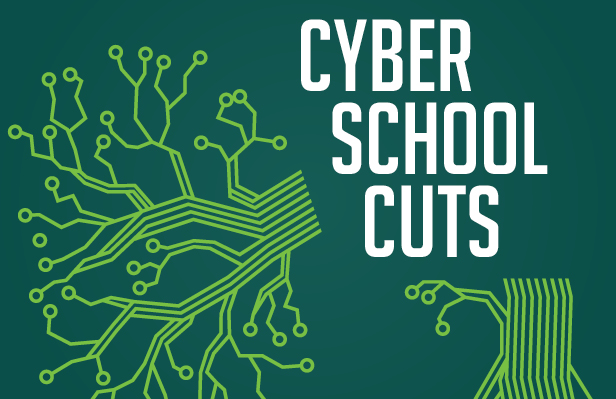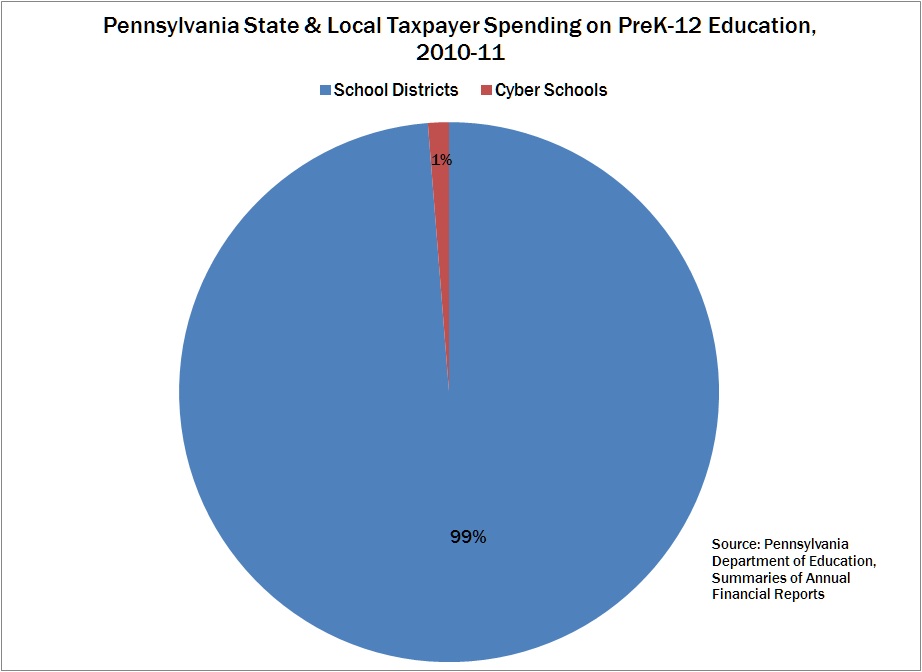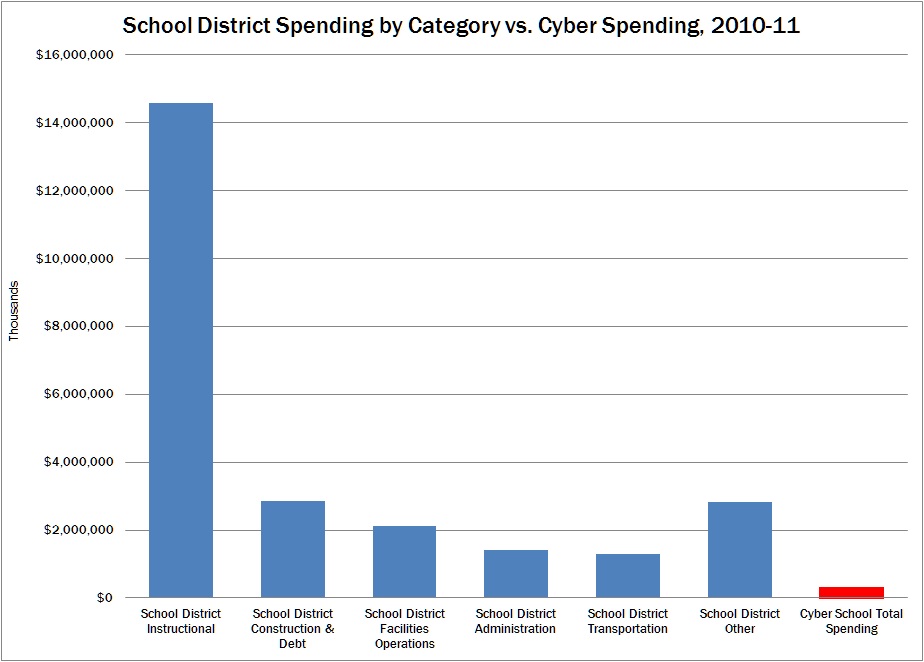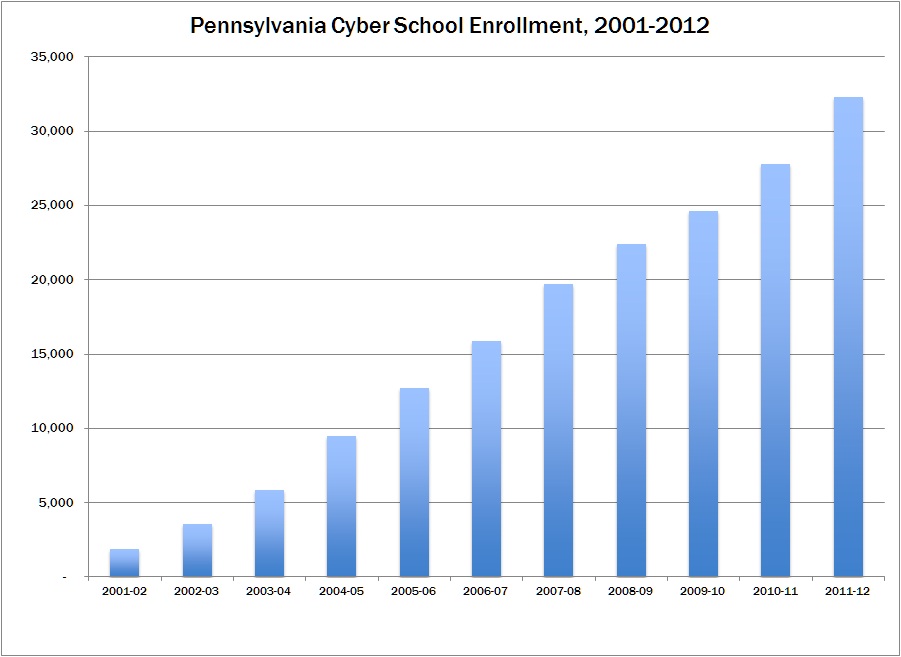Memo

Cyber School Funding in Pennsylvania
Summary
- Cyber schools currently spend significantly less per student than school districts and only represent about 1% of spending on public education.
- Discrepancies in cyber school funding are the result of problems in the overall system of public education finance. Reductions to cyber school funding fail to address these issues.
- Cyber schools have been a popular and successful option for parents. Punitive cuts to cyber school funding will reduce options for families.
- Cyber school students should not be treated as second-class citizens who deserve less funding for their education than students who choose other options.
Overview
- In 2010-11, public cyber schools cost $319 million out of $25 billion on PreK-12 spending—just 1% of Pennsylvania’s total public education spending.

- Like other charter schools, cyber schools receive funds only when families choose them. A portion of taxpayer dollars allocated for a student’s education in her resident school district follows the child to her new cyber school.
| Cyber vs. School District Spending, 2010-11 | ||
| Total | Per-Student | |
| School Districts | $25,095,498,696 | $14,167 |
| Cyber Schools | $319,475,044 | $11,501 |
| Cyber spending as % of school district spending | 1% | 81% |
| Source: Pennsylvania Department of Education, “Expenditure Data for All LEAs,” 2010-11, Click here to view or download the ARF Summary-Level Data report. Total 2010-11 cyber enrollment was 27,779. |
||
- A report by former Auditor General Jack Wagner has been frequently cited claiming Pennsylvania cyber schools spend more per student than those in other states. But cyber school spending is solely a function of public school spending, and Pennsylvania spends significantly more per student than the other states examined in this report.
- The comparison states used in the Auditor General Report spent 12% to 34% less per student in public schools than Pennsylvania, according to federal data.
| Average Per-Student Spending: PA vs. Comparison States | |||
| State | Total* | Difference from PA | Percent Difference |
| Pennsylvania | $14,308 | ||
| Ohio | $12,592 | ($1,788) | -12% |
| Michigan | $11,781 | ($2,599) | -18% |
| Texas | $11,085 | ($3,295) | -23% |
| Arizona | $9,559 | ($4,821) | -34% |
| *Total and current expenditures per pupil in fall enrollment in public elementary and secondary education, by function and state or jurisdiction: 2008-09, Digest of Education Statistics, National Center for Education Statistics, http://nces.ed.gov/programs/digest/d11/tables/dt11_192.asp. | |||
- Not all the money follows the child. By law, school districts deduct spending on certain categories from their total to determine how much funding follows children. Per Section 1725-Aof the Pennsylvania Public School Code, for a regular student, these categories include:
- Nonpublic school programs
- Adult education programs
- Community/junior college programs
- Student transportation services
- Special education programs
- Facilities acquisition
- Construction and improvement services
- Other financing uses, including debt transfers
- Federal funds
- Taken together, these exempted funding categories offer school districts 21 deductions on PDE Form 363, the form used to calculate district payments to charter and cyber schools.

Cyber School Academic Performance
- Despite less funding per student and a high percentage of low-income students from poorly performing school districts, cyber schools are educating Pennsylvania students effectively.
- On average, almost half of all the students attending cyber schools are considered economically disadvantaged. More than 70% of Agora cyber school students qualify for free or reduced lunch.[1]
- Nearly one-third (32%) of cyber school students came from districts that failed to make Adequate Yearly Progress (AYP) in 2011-12.
- To put that in perspective, cyber schools must have 78% of all students in all grade levels proficient in reading and 81% proficient in math to make AYP.
- At Agora Cyber School, almost one third of the students live in Philadelphia, a district which hasn’t made AYP for more than a decade.[2]
- Cyber schools must contend with an influx of students who are academically behind, distorting their academic performance. At Pennsylvania Cyber Charter School, kids who have been enrolled since kindergarten or first grade score 17% higher in math and 14% higher in reading than newly enrolled students.[3]
- Cyber schools are held to a higher standard of academic performance than traditional school districts.
- Cyber schools must meet test participation, graduation and academic performance goals in every demographic group, while a district achieves AYP if it meets the goals in any one age group, such as Grades 3-5, 6-8, or grade 11.
- Cybers more closely reflect school districts in size and scope, yet they are considered individual schools when it comes to evaluating AYP.
- Cyber schools as a group met more than half of their AYP goals in 2012 and three schools met AYP when assessed as districts.
- Ultimately, cyber schools must answer to parents who can choose another school for their child if they think a different one would serve her better. However, the massive growth in cyber enrollment suggests broad parental satisfaction with the schools.
Enrollment: How Popular are Cyber Schools?
- Since the legislature authorized cyber schools in 2001, cyber school enrollment has grown 16-fold in just 11 years, to more than 32,000 students in 2011-12.
- Cyber schools are proving a highly popular public school choice option for families, valued for their flexibility and ability to offer individualized learning.

Funding Proposals for Cyber Schools in 2013
Repairing the so-called pension “double-dip.”
- The “employer cost” of school pensions is paid jointly by the school district and state, with the state sending a payment (on average about half the total pension cost) to school districts to cover pension contributions. This state payment is included in a district’s total spending on the PDE 363 form upon which the level of cyber school funding is based.
- The state also sends a pension payment to cyber and charter schools to cover part of their pension costs. Thus, school districts argue that cyber schools receive two employer pension payments from the state, creating a “double-dip”—or at least an overpayment.
- Removing the school district’s pension payment does not level the playing field or eliminate the supposed “double-dip”. This is because cyber schools (and other charters) do notreceive the same amount per student for pension costs that school districts receive—the figure is already reduced via deductions allowed through the PDE 363.
- This situation is compounded by the fact that all school districts’ cyber school payment calculations lag by a year, as they’re based on the previous year’s budgeted expenses.
- So in 2012-13, the PSERS contribution rate for districts is 12.36%. For 2013-14, however, the rate will be 16.75%. In short, school district pension payments for cyber schools are already nearly 36% lower than they should be.
- To remedy any pension overpayments, a better solution is to eliminate the separate employer contribution that cyber schools receive from the state for pensions.
Other problematic funding proposals.
- Under proposed bills, school districts would deduct 50% of the cost of any in-house cyber program they offer from the payments they owe cyber schools. Instead of creating competition, this change favors school districts and penalizes cyber school students. Under existing law, school districts have an incentive to create their own qualityonline programs to keep students and retain the funding that goes with them. But under this proposal, school districts would keep funding even with a lousy district-run online program that doesn’t attract any parents.
- The measure would have serious effects on parental choice: It would limit competition and effectively take the decision about which cyber program is better out of parents’ hands.
- Genuine school choice allows public money to flow freely to the schools parents choose for their children, prompting lagging public schools to improve their performance before getting more tax dollars.
- Cyber schools already capably educate students for less. However, their costs are not necessarily less than those of regular public schools. Cyber schools still incur many of the same costs that school districts do.
- They still pay for administration buildings and smaller classrooms in which teachers conduct class by camera. And even though they may not have traditional libraries, they offer electronic libraries and scholarly subscription services that still require funding.
- Many also offer extracurricular or supplemental activities, such as mobile science labs, performing arts centers and “blended learning” centers that allow students supervised in-person learning time within their online schedules.
- According to Section 1749-A of the Public School Code, cyber schools must still provide health services to their students mandated under Article XIV. That means they must offer a certified nurse, doctor and dentist.
- In addition, cyber schools have higher technology costs than traditional public schools.
Fund balances and cash flow.
- Recent legislative measures have proposed capping cyber school fund balances at 8% to 12.5% of budgeted expenditures, citing similar caps on school districts.
- However, the 12.5% cap on school districts applies only when school districts are preparing to raise local taxes, and many school districts greatly exceed this cap.
- Cyber schools are heavily dependent on fund balances to maintain daily operations, as more than half of school districts delay payments to cyber schools.
Principles for Cyber School Funding Reform
- Authorize direct pay from the state to cyber schools, so cyber schools do not have to wait for payment from school districts.
- Preserve school options for parents and students.
- Don’t treat cyber school students as second-class citizens.
- Proposals that simply aim to cut cyber school funding will damage the schools’ ability to function and provide a quality education for Pennsylvania families.
- Don’t create an unfair playing field. For example, giving school districts a partial or full deduction in their payments to cyber schools because they have an in-house cyber program will effectively reduce educational choice. Such measures privilege one schooling option over another, rather than allowing different schools and programs to compete on their own merits.
- Avoid creating fund balance limits for cyber and other charter schools without enacting direct pay from the state to these schools.
- Create meaningful education funding reform by fixing the statewide funding formula for all schools, not singling out cyber schools.
- Per-student spending across Pennsylvania’s 500 school districts varies widely.
- Highest: Lower Merion School District–$27,000 per student
- Lowest: Mt Carmel Area School District–$10,000 per student
- Cyber, charter and special education funding are derived from these widely varying per-student spending rates.
- Essential reform must examine the basic funding formula for school districts, particularly the “hold harmless” principle, in which school districts are guaranteed the previous year’s funding level regardless of how student enrollment changed. This 20-year practice has resulted in overfunding declining districts, while expanding districts receive less than they need.
# # #
Priya Abraham is a senior policy analyst and Elizabeth Stelle a policy analyst with the Commonwealth Foundation, www.CommonwealthFoundation.org.